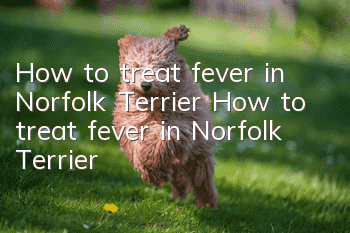How to treat fever in Norfolk Terrier How to treat fever in Norfolk Terrier

How to deal with fever in Norfolk Terrier:
1. Do not touch the belly to determine whether the dog has a fever. If you really need to rely on your hands, you should touch the side of the dog's inner ear (you must have experience)! If you want to measure the puppy's temperature, you can use an anal meter used for children and gently insert it into the dog's body to measure;
2. If your dog has a fever, please do not feed powerful western medicine antipyretics, especially for puppies, as they will have serious side effects.
3. Sometimes, puppies are prone to fever, such as squirrel dogs, Chihuahuas, Pekingese dogs, Cocker Spaniels, Lhasa Apso dogs, noble ladies, etc., which are prone to fever; it is difficult for inexperienced dog owners to detect it. of.
4. Take puppies as an example, if the body temperature exceeds 40°C, it is considered to be feverish; however, sometimes a slightly higher body temperature is not a sign of illness. Some puppies may have a one or two degree difference at different times of day due to mood, activity or environmental influences.
5. Usually the main cause of persistent fever in puppies is bacterial infection, which may be viral or bacterial. There are also other reasons, such as heat stroke, low blood calcium and cancer, and the heat lasts for a long time Don’t retreat. Most suffer from blood cancer, an excess of white blood cells.
6. The furry skin of most puppies will not heat up. If the weather is hot in summer, they will stick out their tongues and pant to dissipate heat in this way, because dogs do not have sweat glands.
7. Dogs sometimes stay in unventilated places in summer and are exposed to the scorching sun for too long. Even if they pant and stick out their tongues, they will not cool down. At this time, it should be placed in a ventilated and cool place.
8. There are some signs that can tell us that a puppy has a fever, such as listlessness, "miserable" expression, loss of appetite, etc.; some puppies have rapid breathing and increased heartbeat.
Once we notice it, we should seek veterinary treatment immediately.
Finally, keep in mind: it is not terrible for dogs to get sick, but dog owners must treat their dogs scientifically and safely;
When you have time, you can learn more about dog diseases, so that you won’t be confused when you get sick, and both people and dogs will suffer.
- What should I do if my Norfolk Terrier has pharyngitis? How to prevent and treat pharyngitis in my Norfolk Terrier?
- What foods should Norfolk Terriers eat? What foods should Norfolk Terriers eat?
- How to make homemade dog food for Norfolk Terrier. Introduction to homemade dog food recipe for Norfolk Terrier.
- How to train Norfolk Terrier Norfolk Terrier training tips
- What kind of dog food is good for Giant Schnauzers? Recommended dog food options for Giant Schnauzers
- What’s wrong with Norfolk Terrier’s dry nose? How to deal with Norfolk Terrier’s dry nose
- How to train a Giant Schnauzer Giant Schnauzer training tips
- How to solve the problem of giant schnauzer vomiting and not eating
- What is the personality of the Australian Shepherd? Introduction to the personality characteristics of the Australian Shepherd
- How to train an Australian Shepherd to stand? How to train an Australian Shepherd to stand?



